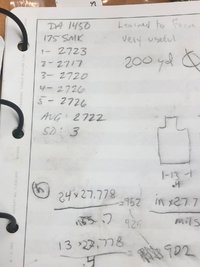dcmdon
NES Member
Hi all.
I'm looking for some thoughts on using hot .308 loads in my AR10. Here's the details.
The ammo is 175 gr Sierra Match King handloads that I developed to use in my bolt gun when I was taking the advanced precision scoped rifle class at Sig.
It chrono'd at 2720 FPS out of a 22 in barrel on my bolt gun.
It recoils noticeably more than 168 or 175 gr Federal Gold Medal Match
The gun is a rifle I built using a Mega upper and lower as well as a Lilja barrel with a bolt lapped to the barrel extension.
Its also got an adjustable gas block.
When I started shooting these rounds, I turned the gas way down and fired the first shot. There were no pressure signs on the case or primer and the case did not eject from the rifle.
I gradually turned up the gas over the next 4 rounds until the bolt just locked back on an empty mag.
With this level of gas, there were still no pressure signs on the case and also no signs of extraction happening when there was still pressure in the barrel. (deformed rim, gouges in the case, etc).
So by all measures the gun is functioning properly with the ammo.
My question is more along the lines of the strength of the bolt compared to a bolt gun bolt.
Is there a harm in this?
Why? You may ask?
I'd like to try my hand at shooting this AR out at extended distances. It is well sub MOA (average 5 shot groups, not a cherry picked 3 shot group) at 200 yards and this ammo has proven to have a very small standard deviation of 3 FPS.
Like I said, I developed it for a specific bolt gun, but it has proven to be very accurate in every gun I've shot it through. Including my A-Bolt Micro, which weighs 6.2 lbs with a scope. (ouch!!!)
Any personal experience on the durability of AR10 bolts would be welcomed.
Thanks,
Don
I'm looking for some thoughts on using hot .308 loads in my AR10. Here's the details.
The ammo is 175 gr Sierra Match King handloads that I developed to use in my bolt gun when I was taking the advanced precision scoped rifle class at Sig.
It chrono'd at 2720 FPS out of a 22 in barrel on my bolt gun.
It recoils noticeably more than 168 or 175 gr Federal Gold Medal Match
The gun is a rifle I built using a Mega upper and lower as well as a Lilja barrel with a bolt lapped to the barrel extension.
Its also got an adjustable gas block.
When I started shooting these rounds, I turned the gas way down and fired the first shot. There were no pressure signs on the case or primer and the case did not eject from the rifle.
I gradually turned up the gas over the next 4 rounds until the bolt just locked back on an empty mag.
With this level of gas, there were still no pressure signs on the case and also no signs of extraction happening when there was still pressure in the barrel. (deformed rim, gouges in the case, etc).
So by all measures the gun is functioning properly with the ammo.
My question is more along the lines of the strength of the bolt compared to a bolt gun bolt.
Is there a harm in this?
Why? You may ask?
I'd like to try my hand at shooting this AR out at extended distances. It is well sub MOA (average 5 shot groups, not a cherry picked 3 shot group) at 200 yards and this ammo has proven to have a very small standard deviation of 3 FPS.
Like I said, I developed it for a specific bolt gun, but it has proven to be very accurate in every gun I've shot it through. Including my A-Bolt Micro, which weighs 6.2 lbs with a scope. (ouch!!!)
Any personal experience on the durability of AR10 bolts would be welcomed.
Thanks,
Don
Last edited:


